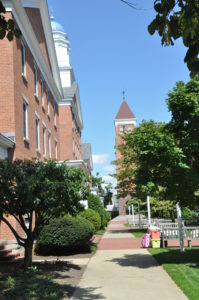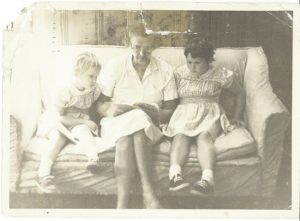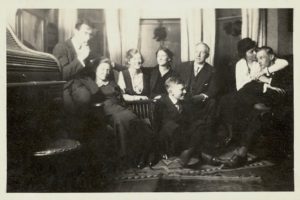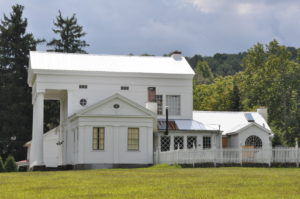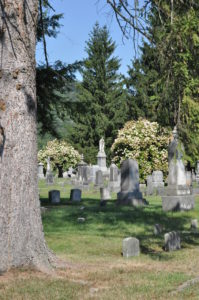“Dontchaknow”punctuated her every third or fourth sentence.
Granny was fabulous. She was easily moved to laughter, her eyes sparkling and her face a constellation of wrinkles. She made brownies and applesauce. She took us out to lunch at some restaurant between Hingham and Cohasset and bought us as many orders of french-fries as we wanted.
I still have her brownie recipe—“Hazie’s Brownies”—and I concede that I have improved it somewhat. Nothing, however, could have been improved on Granny herself.
There is an old photograph album assembled in 1910, pictures of Berkshire, New York, and life at Wyoming Seminary, a boarding school in Kingston, Pennsylvania. Beth Doherty in the Alumni Office had determined that there was much that might be of interest to us in old yearbooks, so we stopped at the campus, not far from Wilkes-Barre, on route to Scranton.
We recognized a lot: the bell tower, Swetlands Hall and where Granny lived. We paged through every yearbook from 1906 to 1912 and found mention of Granny, who attended for only a year, and her brother Leon, who graduated in 1908.
Granny was Hazel Harriet Wavle Cutler Pope.
Granny seems to have been born in Binghamton, New York, and to have lived in Berkshire from the late 1890s to about 1912. Leon was one of four students to be the first graduating class of Berkshire High School; Granny followed in 1910. The time at “The Sem,” as it is affectionately known, was “post-graduate” and “pre-collegiate” education. Leon went on to Harvard (A.B. 1913, LL.B., 1915) but The Sem was the end of schooling for Granny. Their baby sister Ruth Geraldine graduated from Cambridge Latin in Massachusetts and studied at Pratt.
She and David Cutler must have fallen in love over the counter of the candy store the family ran. They married in 1919 when David, having achieved the rank of first lieutenant in the Yankee Division of the American Expeditionary Force, returned from the Western Front of France. They settled in Nashua, New Hampshire, had a son David, then transferred briefly to Middletown, Ohio, where my father Calvin was born in 1923. They returned to Nashua where David died suddenly in 1926 from a staph infection. Granny gathered up her boys and returned to Cambridge, the house at 11 Story Street and the candy store at 33 Brattle Street. At some point around 1931 she met the widower Arthur “Archie” Pope, who had a son named Steven. They married and Granny moved into his house on Miles Road in Hingham, Massachusetts, and Archie became, some years on, my Gramps.
This much I knew. What I didn’t know was who Granny’s parents had been and how they had met.
Granny’s mother, Laura Alice Macey, was born in Birmingham, England, in 1864 and came to the United States with her parents Selina and Thomas around 1869. Through the resources of Ancestry.com I learned quite a bit about her parents’ families. There was very little about the Maceys arrival on this side of the pond or what happened then, except that Thomas died in 1874. A little more digging determined that Laura was one of about six children and that they were farmed to families in the vicinity of Caroline, New York, when Selina went back to England in 1875. Selina returned around 1879 and married Henry Buttman, but that is another story, one whose details are not yet clear.
Harriet N. and the Reverend Oliver P. Legge were Laura’s foster parents. Granny’s middle name“Harriet” honored Harriet; Leon’s middle name “Oliver” acknowledged the good Reverend. I assume, but I cannot be sure, that Laura lived with the Legge’s from the time she was ten until she was married.
Laura Macey married George Albert Wavle in 1887 or thereabouts. This is where the mystery gets tangled. Laura’s history and ancestry is pretty clear. Albert’s—he preferred to be called “Albert”—history is obscure. I suspect he was born in the late 1850s. I know he was a farmer. I know he was living in Berkshire in 1900 and 1910, and I have a photograph of “the Wavle house,” a place called “Maple Rest.” I know he moved the family to Cambridge around the time that Leon was accepted to Harvard.
And those are the facts about Laura and Albert that I think I can depend on.
We drove from Scranton to Owego, New York, making a detour through Harford, Pennsylvania, to see “Mrs. Pinchot,” the Greek Revival Mansion that has been the centerpiece of The Bronson Pinchot Project on DIY network. Mr. Pinchot might have been at home–there were quite a few cars and a light shone in one window–but no one came out as I walked along the fence taking pictures.
Tropical Storm Lee in the fall of 2011 wreaked disaster on Owego and put the lower level of the Historical Society—the library and archives—about four and a half feet under water. The staff couldn’t find any publications or files that might help me but they suggested I call Ray Hunt, the co-author of a couple of books about Granny’s one-time hometown of Berkshire.
I left my Dear One in the hotel and set out for Berkshire and Ray’s house a few miles away. I bought both his books—which included pictures of Granny and Leon. He scanned a couple of my pictures and we thought deeply–but not productively–about where the Wavle house might have been. He’ll consult with others.
The next day it was back to Berkshire in an attempt to document the Wavle markers in Evergreen Cemetery. Apparently George Albert Wavle may be buried there. I know for certain he died 12 August 1913; we did not, however find his headstone. There is nothing about Laura. I have no idea when she died, except that it was after 1931.
Finding a tombstone in a cemetery when you have no idea how the cemetery is organized is challenging. George was in section G-13. Well, we found stones with letters, including A, B, F, L, M. S and T. Turns out that the letters alluded to the surnames of the families that owned the plots. Stones with numbers–we found “13”–don’t seem to mean much of anything.
Time, moreover, was running short. We needed to be at the Historical Society in Fonda, New York, which closed at four, and it was a three-hour drive away.
A trio of phone numbers on the placard at the entrance of the cemetery gave me hope, and I left messages. Fortunately, Mr. Whittaker, one of the caretakers, called back. Once he was able to get me to distinguish the compass points as they related to the cemetery, I found some of the Wavle memorials, none of which bore the name George Albert.
We had to be on our way. Hills, dales, rivers and copses beckoned. I thought I might answer some of the questions in Montgomery County some three-plus hours to the east.
The sky was blue, the clouds hills of white and shadows of gray. We fired up Serena GPS and aimed the Toyota at Fonda.


